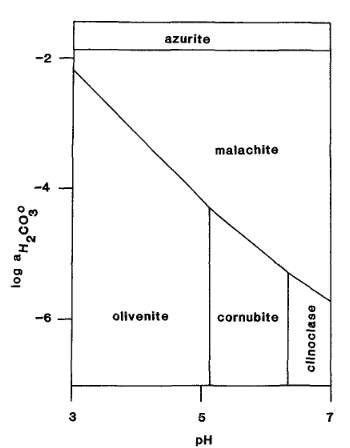At the Clara Mine, Oberwolfach, Ortenaukreis, Freiburg Region, Baden-Württemberg, Germany, clinoclase is associated with olivenite, conichalcite, malachite and azurite, all on a baryte-rich matrix (R&M90.1.42).
Clinoclase from the Clara Mine - Image
At the type locality, Wheal Gorland, St Day, Cornwall, England, UK, clinoclase> is a rare secondary mineral in the oxidised zone of arsenic-rich hydrothermal base-metal deposits. Associated minerals include olivenite, liroconite and cornwallite (Mindat).
Clinoclase from Wheal Gorland - Image
At the Majuba Hill Mine, Antelope Mining District, Pershing County, Nevada, USA, clinoclase has been found (Mindat photo).
Clinoclase from Majuba Hill - Image
At the Tintic Mining District, Juab County, Utah, USA, clinoclase is found in excellent specimens, particularly in the Mammoth mine and in other adjacent mines. It occurs as dark blue-green individual crystals from less than a millimeter up to a centimeter or two, as intergrown crystal clusters, particularly as hemispheres, and sometimes as botryoidal crystalline masses. It is usually associated with azurite, malachite, olivenite and tyrolite. It is generally one of the later arsenates, developed upon olivenite and locally covered by azurite (MinRec 55.2.193).
Clinoclase from the Tintic District - Image
Stability Diagrams
The Activity-pH diagram below was calculated at 298.2 K for the main Cu2+ and Pb2+ arsenate minerals. Boundaries are calculated for constant activities (roughly equivalent to concentrations) of Pb2+ and Cl- ions in solution, over a range of values of pH and of Cu2+ activity. Higher chloride activites make the stability fields of bayldonite and duftite vanish, with respect to the encroachment of that of mimetite (LMW p269).

The arsenate mineral formulae are:
philipsbornite PbAl3(AsO4)(AsO3OH)(OH)6
mimetite Pb5(AsO4)3Cl
duftite PbCu(AsO4)(OH)
bayldonite Cu3PbO(AsO3OH)2(OH)2
olivenite Cu2(AsO4)(OH)
cornwallite Cu5(AsO4)2(OH)4
clinoclase Cu3(AsO4)(OH)3
The Activity-pH diagram below was calculated at 298.2 K for some carbonates and copper arsenates for constant activity (roughly equivalent to concentration) of H2AsO4- in solution, over a range of values of pH and of H2CO3 activity (MM 52.687).

The mineral formulae are:
azurite: Cu3(CO3)2(OH)2
malachite: Cu2(CO3)(OH)2
olivenite: Cu2(AsO4)(OH)
cornubite: Cu5(AsO4)2(OH)4
clinoclase: Cu3(AsO4)(OH)3
The Activity-pH diagram below was calculated at 298.2 K for some arsenates and sulphates for constant activity (roughly equivalent to concentration) of H2AsO4- in solution, over a range of values of pH and of SO42- activity (MM 52.689).

The mineral formulae are:
chalcanthite: Cu(SO4).5H2O
antlerite: Cu2+3(SO4)(OH)4
brochantite: Cu4(SO4)(OH)6
olivenite: Cu2(AsO4)(OH)
cornubite: Cu5(AsO4)2(OH)4
clinoclase: Cu3(AsO4)(OH)3
Back to Minerals